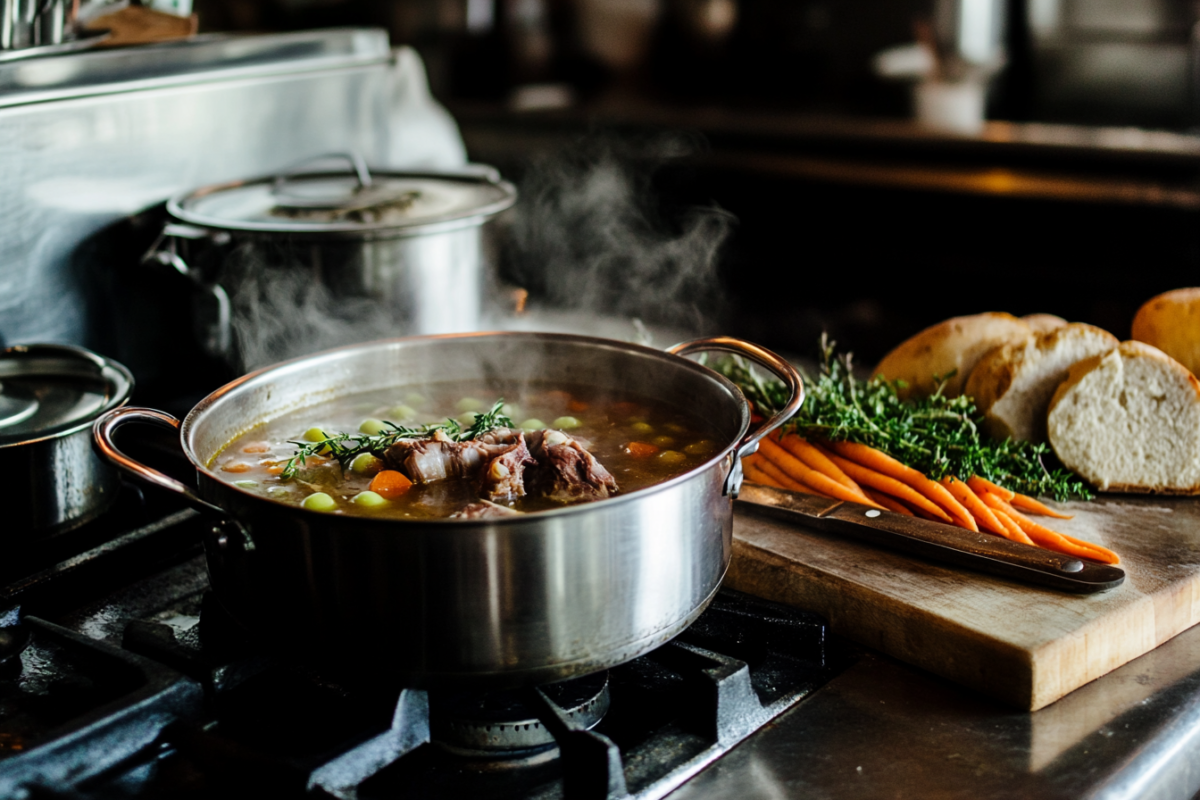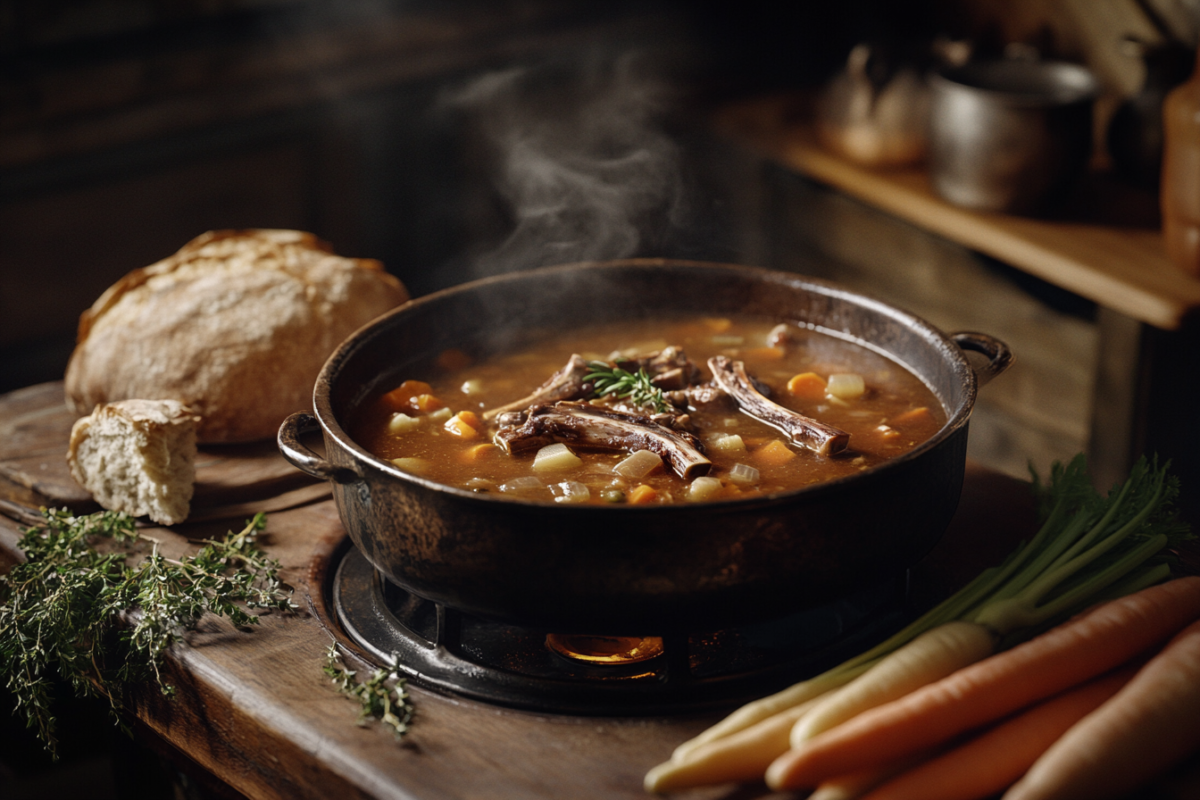When it comes to cooking, sometimes the best meals come from the most unexpected cuts of meat. Beef Neck Bone are a prime example of this. Often overlooked, these meaty, marrow-rich bones offer incredible flavor and nutrition when cooked properly. Whether you’re making a savory broth, a hearty soup, or a slow-cooked stew, beef neck bones can transform a simple dish into a rich and comforting experience.
What Are Beef Neck Bones?
Introduction to Beef Neck Bones
Beef neck bones are a flavorful and often underappreciated cut of meat, commonly found in both home kitchens and professional kitchens alike. These bones come from the neck of a cow and are filled with rich marrow and meat. The bones themselves are relatively inexpensive, making them an excellent choice for budget-conscious cooks. Yet, despite their low cost, beef neck bones can deliver a profound depth of flavor when cooked slowly and carefully.
Rich in collagen, which breaks down into gelatin during slow cooking, beef neck bones contribute a silky, rich texture to broths and stews. Their tender meat and flavorful marrow make them perfect for recipes that require a long simmering time, which helps to extract all the savory goodness.
In many cultures, beef neck bones are used to make rich, nutritious broths that form the base of soups and sauces. From bone broth to hearty stews, this cut is incredibly versatile and can be cooked in numerous ways to highlight its natural flavors.
Why Cook with Beef Neck Bones?
One of the best things about beef neck bones is their versatility. Whether you’re preparing a comforting soup or a rich, flavorful broth, this humble cut has the power to elevate your dish.
- Flavorful and Budget-Friendly Choice: Compared to other cuts of beef, beef neck bones are very affordable. They are perfect for those looking to create delicious meals on a budget without sacrificing flavor. Despite being economical, they have a complex, savory taste that can rival more expensive cuts of meat.
- Versatility in Recipes: Beef neck bones can be used in a variety of dishes, from soups to stews, braises, and even slow-cooked roasts. Their high collagen content makes them an ideal base for making rich broths that are both flavorful and nutritious. In fact, when simmered for several hours, the marrow-rich bones release nutrients that are beneficial to joints, skin, and overall health.
Selecting and Preparing Beef Neck Bones
Choosing the Right Beef Neck Bones
When it comes to cooking with beef neck bones, the first step is choosing the right cut. Luckily, this flavorful meat is widely available, and you can find it at various locations.
Where to Buy Beef Neck Bones
You can find beef neck bones at most local butcher shops, where you’re likely to find high-quality, fresh cuts. Butchers often have access to a wide range of meats, and they can help you pick out the best beef neck bones for your recipe. If you’re looking for more convenience, several online stores also offer beef neck bones shipped directly to your door. Websites that specialize in fresh meat delivery often have good deals on this cut, ensuring it’s packed and delivered to preserve its quality.
While shopping online, make sure to read reviews and check the freshness guarantee to ensure you’re getting the best product. Freshness is key for a tasty result!
How to Select Fresh and High-Quality Beef Neck Bones
When you’re selecting beef neck bones, there are a few things to keep an eye out for. Start by checking the appearance of the meat. The bones should have a healthy, pinkish color, with some marbling of fat visible around the edges. Avoid cuts with any signs of discoloration or excess dry spots, as this can indicate poor quality or aging.
Next, give the bones a light sniff. Fresh beef neck bones should have a clean, meaty scent. If they smell sour or off in any way, it’s best to pass on that batch. Finally, feel the texture of the meat; it should be firm but not too tough. Soft or squishy spots might indicate that the bones are not as fresh as they should be.
Preparing Beef Neck Bones for Cooking
Once you’ve selected your beef neck bones, the next step is preparing them for cooking. Proper preparation ensures the best flavor and texture, making all the difference in your final dish.
Cleaning Beef Neck Bones
Cleaning beef neck bones is an essential part of the preparation process. Start by rinsing the bones under cold water to remove any blood or debris from the surface. After that, use a sharp knife to trim away any excess fat that might be hanging off the bones. While some fat is necessary for flavor, too much can result in a greasy broth or dish. By trimming the fat, you allow the beef neck bones to release their full flavor without overwhelming the dish.
Pre-Cooking Techniques
Before diving into your recipe, consider using a pre-cooking technique to enhance the flavor of your beef neck bones. One effective method is blanching the bones. Simply place them in boiling water for a few minutes, then remove and discard the water. This step helps eliminate impurities, resulting in a cleaner taste for your broth or stew.
Alternatively, roasting the beef neck bones in the oven before cooking can deepen the flavor. Spread the bones on a baking sheet and roast them at 400°F (200°C) for 30-40 minutes. The high heat caramelizes the meat and enhances its savory, rich flavor, making it an excellent base for broths and soups.
Cooking with Beef Neck Bones

Best Cooking Methods for Beef Neck Bones
When it comes to cooking beef neck bones, the key is patience. This cut of meat thrives in slow cooking, where its collagen breaks down into flavorful gelatin, resulting in a rich and savory broth or stew. Let’s dive into the best methods for cooking beef neck bones, starting with slow cooking.
Slow-Cooking Beef Neck Bones
Why Slow Cooking is Ideal
Slow cooking is the perfect method for beef neck bones because it allows the meat and marrow to break down slowly, releasing all of their rich flavors into the broth. As the bones simmer, the collagen in the meat dissolves, turning into gelatin, which gives the broth a smooth, silky texture. This process not only makes the meat tender but also maximizes the nutritional value of the bones, making it ideal for creating nourishing broths and soups.
Slow cooking is also incredibly convenient. You can let the bones cook for hours, allowing the flavors to meld together while you go about your day. This method requires minimal effort but yields maximum flavor.
Step-by-Step Process for Slow Cooking
Here’s how you can slow cook beef neck bones to perfection:
- Prepare the Beef Neck Bones: Start by cleaning and trimming your beef neck bones as described earlier.
- Season the Bones: Add your favorite seasonings, such as salt, pepper, garlic, onion, and herbs like thyme or rosemary. If you want a more complex flavor, you can add a dash of soy sauce or Worcestershire sauce.
- Add Liquid: Pour enough water or broth into your slow cooker to fully submerge the bones. You can also add a splash of vinegar, which helps draw out the minerals and nutrients from the bones.
- Set the Cooker: Set your slow cooker to low heat and let it cook for 6 to 8 hours. Alternatively, if you’re using a stovetop, bring the liquid to a boil, then reduce the heat to a simmer and cover the pot.
- Skim the Surface: Periodically skim off any impurities or foam that forms on top of the broth to keep it clean and clear.
- Taste and Adjust: Once the meat is tender and the broth is flavorful, taste it and adjust the seasoning as necessary before serving.
By the end of this process, you’ll have a rich, savory broth that’s perfect for a variety of dishes.
Making Beef Neck Bone Broth
Beef neck bones are also the perfect base for a hearty bone broth, packed with nutrients like collagen, amino acids, and minerals that are great for joint health and skin elasticity. Here’s how to make a simple and delicious beef neck bone broth:
Ingredients and Recipe for Beef Neck Bone Broth
- 2-3 pounds of beef neck bones
- 2 tablespoons apple cider vinegar
- 1 onion, quartered
- 2 carrots, chopped
- 2 celery stalks, chopped
- 4 cloves garlic, smashed
- 1-2 bay leaves
- A few sprigs of fresh thyme or rosemary
- 10 cups water
- Salt and pepper to taste
Instructions:
- Prepare the Ingredients: Clean and trim the beef neck bones as discussed earlier. Then, place them in a large pot or slow cooker.
- Add Vegetables and Herbs: Add the onion, carrots, celery, garlic, and herbs to the pot with the bones.
- Add Vinegar and Water: Pour in the water and add the apple cider vinegar, which helps to extract the nutrients from the bones.
- Cook the Broth: Bring the mixture to a boil, then reduce to a simmer. Let it cook for 12 to 24 hours, depending on how rich you want your broth to be.
- Strain and Serve: Once the broth is ready, strain out the solids and season with salt and pepper to taste.
Health Benefits of Beef Broth
This beef bone broth is loaded with nutrients like collagen, which is excellent for joint health, skin elasticity, and even digestive support. It also provides a good amount of minerals such as calcium and magnesium, which are essential for bone health.
Beef Neck Bone Soup Recipe
If you’re craving something hearty, beef neck bones make a fantastic base for a soup. Here’s a simple recipe to create a flavorful, comforting beef neck bone soup:
Ingredients:
- 2 pounds of beef neck bones
- 1 large onion, diced
- 2 carrots, chopped
- 2 celery stalks, chopped
- 3 potatoes, peeled and diced
- 1 can diced tomatoes
- 4 cloves garlic, minced
- 1 teaspoon thyme
- 1 teaspoon rosemary
- 6 cups beef broth or water
- Salt and pepper to taste
- 1 tablespoon olive oil
Instructions:
Sear the Meat: Warm olive oil in a large pot over medium heat. Add the beef neck bones and sear them on all sides to enhance flavor. Remove the bones and set them aside.
Sauté the Vegetables: In the same pot, cook the onion, carrots, and celery for about 5 minutes, until softened.
Add the Broth and Simmer: Return the beef neck bones to the pot, along with the diced tomatoes, thyme, rosemary, and beef broth or water. Bring to a boil, then lower the heat and simmer for 2-3 hours, until the meat is tender and falls off the bones.
Finish and Serve: Add the diced potatoes and simmer for another 30 minutes until they are tender. Adjust seasoning to taste and serve the soup hot with crusty bread on the side.
This hearty soup is full of flavor, with tender meat, vegetables, and a savory broth that will leave you feeling satisfied.
Enhancing the Flavor of Beef Neck Bones
Now that you’ve learned some of the best cooking methods for beef neck bones, it’s time to enhance their flavor with the right spices and vegetables.
Using Herbs and Spices
To bring out the best in your beef neck bones, don’t forget to season them well. Beef neck bones pair wonderfully with herbs like thyme, rosemary, and bay leaves. These herbs lend a savory, aromatic quality to the meat and broth. You can also add spices like black pepper, garlic, and paprika for an extra flavor boost.
Pairing Beef Neck Bones with Vegetables
Certain vegetables complement beef neck bones perfectly. Carrots, celery, and onions form the classic trio, known as mirepoix, which adds a savory, umami flavor to the dish. Other great options include potatoes, parsnips, and tomatoes, which enhance the richness of the broth while adding texture to the dish.
Serving Suggestions
Once your dish is ready, consider serving it with some crusty bread to soak up the rich broth. For a light accompaniment, a simple green salad with lemon dressing pairs wonderfully with the deep flavors of beef neck bone dishes.
Storage and Leftover Tips
How to Store Cooked Beef Neck Bones
Once you’ve enjoyed your beef neck bones meal, it’s important to store any leftovers properly to maintain freshness and flavor for later use.
Refrigerating and Freezing Tips
If you plan to eat the leftovers within the next few days, refrigerating them is your best bet. Allow the beef neck bones to cool down to room temperature before placing them in an airtight container. Store the bones and broth separately if you want to preserve their quality longer. In the fridge, they’ll stay fresh for up to 3-4 days.
Freezing is the best option for extended storage. Simply transfer the beef neck bones and broth into freezer-safe containers or bags, making sure to remove as much air as possible. Frozen beef neck bones can last for up to 3 months. When you’re ready to use them, thaw the bones in the refrigerator overnight and reheat them gently to preserve their flavor and texture.
Creative Ways to Use Leftovers
Don’t let those leftovers go to waste! There are plenty of creative ways to repurpose your beef neck bones into new dishes that will surprise and delight your taste buds.
Transforming Leftovers into New Dishes
- Beef Neck Bone Tacos: Shred the leftover beef neck bones and combine them with your favorite taco toppings, like diced onions, cilantro, and a squeeze of lime. These make for a delicious and unique taco filling that’s sure to impress.
- Beef Neck Bone Casserole: Take the leftover meat and mix it with rice, vegetables, and cheese to create a comforting casserole. Bake it until golden and bubbly, and you’ll have a brand-new dish that feels like a treat.
- Beef Neck Bone Sandwiches: Shred the meat and pile it on a bun with pickled onions and a tangy sauce for a hearty sandwich that uses up every last bit of the leftover beef neck bones.
Nutritional Benefits and Health Aspects
Health Benefits of Beef Neck Bones
Beef neck bones are not only a flavorful addition to your meals but also provide a variety of health benefits. Rich in nutrients, they offer more than just a tasty meal – they can contribute to better joint health, skin elasticity, and overall well-being.
Nutritional Profile
Beef neck bones are an excellent source of protein, which is essential for muscle repair and growth. This cut is also packed with collagen, which breaks down into gelatin when cooked slowly, offering many health benefits, particularly for joints and skin. Collagen helps improve skin elasticity, reduce wrinkles, and support joint flexibility by cushioning the bones and ligaments.
In addition to protein and collagen, beef neck bones contain essential minerals like calcium, phosphorus, and magnesium, which are important for bone health and maintaining proper muscle function. The high-fat content in the bones provides a good source of energy, but it’s important to trim excess fat for a healthier dish.
Bone Broth Benefits
When you make beef neck bone broth, you unlock even more nutritional benefits. The slow-cooking process draws out valuable minerals and amino acids, which support joint health and skin health. Bone broth, rich in collagen and gelatin, helps to reduce inflammation, support digestive health, and even promote stronger hair and nails.
Drinking bone broth regularly can help soothe the digestive tract, reduce joint pain, and improve the health of connective tissues. It’s a natural source of glycosaminoglycans (GAGs), which support cartilage health and reduce the symptoms of osteoarthritis.
FAQs
Are Beef Neck Bones Safe to Eat?
Yes, beef neck bones are safe to eat when cooked properly. Ensure they are fully cooked to avoid any potential foodborne illnesses.
Can I Substitute Beef Neck Bones with Other Cuts?
Yes, you can substitute beef neck bones with other cuts like oxtails, short ribs, or marrow bones, though the flavor may differ slightly.
How Long Should I Cook Beef Neck Bones?
For optimal flavor, beef neck bones should be cooked for 6-8 hours in a slow cooker or simmered for 2-3 hours on the stovetop.
Are Beef Neck Bones Good for Pets?
Yes, beef neck bones can be beneficial for pets, particularly for their joint health due to the collagen and gelatin. However, be sure to cook the bones thoroughly and remove any small pieces that might pose a choking hazard.
Conclusion
Beef neck bones are an affordable, versatile, and nutritious ingredient that can be used in a variety of dishes. Rich in protein, collagen, and essential minerals, they provide numerous health benefits, from supporting joint health to promoting glowing skin. Whether you’re using them for a savory broth, hearty soup, or a creative leftover dish, beef neck bones are a valuable addition to your cooking repertoire.


